Episode 184
What you’ll learn in this episode:
- Why ancient Nubian jewelry is still significant today
- How the Kingdom of Kush rose and fell
- How ancient jewelry motifs, techniques and materials were shared and adapted between cultures
- Why the Museum of Fine Arts Boston has a significant collection of ancient Nubian art, and why it’s being exhibited at the Getty Villa
- Why jewelry is often one of the only pathways to understand ancient cultures
About Dr. Sara E. Cole
Sara E. Cole is Assistant Curator of Antiquities at the J. Paul Getty Museum (Villa). She holds a PhD in Ancient History from Yale University. At the Getty, she is part of the Classical World in Context initiative, which seeks to highlight cross-cultural interactions in antiquity and explore the diversity and interconnectedness of the ancient Mediterranean and Near East through a series of special exhibitions and related publications and public programs. She has curated or assisted with exhibitions of Egyptian, Mesopotamian, Neo-Assyrian, Persian, and Nubian art.
About “Nubia: Jewels of Ancient Sudan” from the Museum of Fine Arts, Boston
October 12, 2022 – April 3, 2023
Getty Villa Museum
For nearly 3,000 years a series of kingdoms – collectively known as the Kingdom of Kush – flourished in ancient Nubia (present-day southern Egypt and northern Sudan). The region was rich in sought-after resources such as gold and ivory and its trade networks reached Egypt, Greece, Rome, and central Africa. This exhibition presents highlights from the Museum of Fine Arts, Boston’s extensive collection of Nubian objects and features superbly crafted jewelry, metalwork, and sculpture exhibiting the wealth and splendor of Nubian society. Learn more about the exhibit at https://www.getty.edu/art/exhibitions/nubian_jewelry/
Photos:
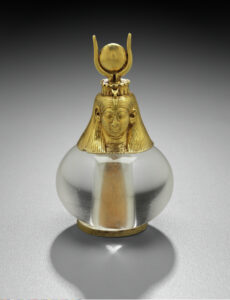
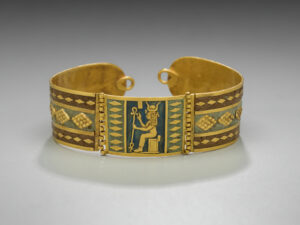
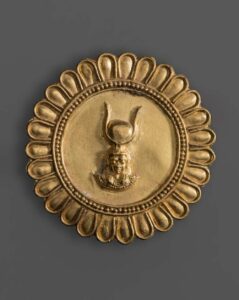
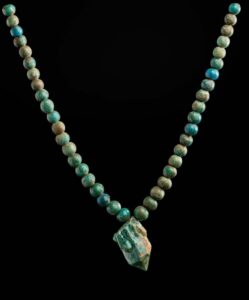
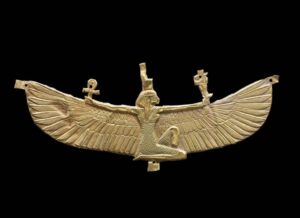
Transcript:
Nubian jewelry is often overshadowed by Egyptian and Greco-Roman jewelry, but the ancient Nubians were the world’s first jewelry pioneers. Their influential work is currently on display at “Nubia: Jewels of Ancient Sudan,” an exhibit at the Getty Villa featuring pieces from the collection of the Museum of Fine Arts in Boston. Dr. Sara E. Cole, assistant curator of the exhibit, joined the Jewelry Journey Podcast to talk about how Nubians developed their own enameling techniques; why jewelry is the key to understanding ancient cultures; and how iconography was shared and adapted throughout the ancient world. Read the episode transcript here.
Sharon: Hello, everyone. Welcome to the Jewelry Journey Podcast. This is the first part of a two-part episode. Please make sure you subscribe so you can hear part two as soon as it’s released later this week.
Today, my guest is Sara Cole, who’s the Assistant Curator of Antiquities at the Getty Villa in Malibu, California. She’s the curator of “Nubia: Jewels of Ancient Sudan,” an exhibit at the Museum of Fine Arts in Boston which showcases Nubian material. These finds were jointly executed early in the last century by Harvard and the Museum of Fine Arts. The exhibit is now open until April 3. Sara received her Ph.D. from Yale, which is amazing. She’s an expert in ancient history and a specialist in material culture of Greco-Roman Egypt. She has studied the cross-pollination of cultures, and we’ll hear a lot more about it today. Sara, welcome to the program.
Sara: Thank you for having me.
Sharon: So glad to have you. Tell us about your own journey. Did you come to jewelry through antiquities or archaeology, or the other way around?
Sara: Yes, through my study of archaeology and Egyptology as a graduate student. That was primarily my introduction to this material. I became familiar with Nubia primarily through the MFA Boston’s tremendous archaeological collection of Nubian material. When I was a graduate student at Yale back in, I think, 2011, I took a graduate seminar on Nubian archaeology with a Nubian specialist named Maria Gatto. In one of our classes, we took the train to Boston and got to spend a day going through the storerooms of the MFA looking at Nubian material. We were primarily looking at pottery that day, but we did get to see some other objects as well.
In 2014, MFA put on its own small exhibition featuring their Nubian jewelry collection, so that brought that material a little bit more into public view. Then in 2019, the MFA did a big exhibition bringing out highlights of their full Nubian collection that was called “Ancient Nubia Now.” Since 2019, they very generously sent parts of this collection to different museums for exhibitions around the world. We’re very fortunate at the Getty Villa that we were able to borrow some of these stunning pieces of jewelry and personal adornment from that collection for this current exhibition.
Sharon: I have to ask you. When you were younger, you say you were interested in Egypt and ancient periods, but very few people go into archaeology. How is it that you stuck with it?
Sara: Museums were really my entry point to the ancient world as a child, which I think is true for a lot of us. I grew up in a small town in Virginia and wasn’t exposed to major museum collections as kid, but we had a small, local museum. It featured mostly local contemporary artists, but one summer they put on view a small touring exhibition of Egyptian material from the Virginia Museum of Fine Arts in Richmond. I was probably 11 or 12 years old. That was my first exposure to ancient Egyptian material, and I just found it incredibly captivating and compelling, and I stuck with that interest.
I ended up doing a bachelor’s degree in classics and then my Ph.D. in ancient history, where I studied a combination of Egyptology, classics and art history. But I’ve always had a great passion for museums in particular because it was my personal entry point to the ancient world. We do have the opportunity, through putting on exhibitions like this, to reach such wide audiences and to bring this material to their attention, things they’ve maybe never seen or considered before. It’s a really wonderful opportunity.
Sharon: It really is. When you say Nubia, a lot of us haven’t really thought about Nubia or Nubian jewels. That’s the entry point or the foundation. What is Nubia? What do you mean by Nubian?
Sara: That’s a great question, because I think a lot of people have heard of Nubia but they’re not quite sure what it is. Traditionally it has received a lot less attention than ancient Egypt, which is this huge, looming civilization. When we talk about ancient Nubia, we’re really talking about a geographical region that was located immediately south of ancient Egypt. They were neighbors. In terms of modern-day geography, it reached essentially from Aswan in what is now southern Egypt down to about Khartoum in present-day Sudan. The contemporary political border between Egypt and Sudan cuts across part of what was ancient Nubia, when the border was located further north between Nubia and Egypt. So, it’s essentially this geographical region going across part of what is today southern Egypt and northern Sudan. For parts of its ancient history, Nubia as a region was actually home to several different cultural groups. It wasn’t always a single, unified culture. So, when we talk about Nubia, we’re talking about the geographical area, and then there were different cultures that lived within Nubia.
Around the third millennium B.C., a political institute called the Kingdom of Kush—because the region was known as Kush in antiquity—arose at the city of Karma in what is today Sudan. It eventually came to conquer essentially all of the region of Nubia. The Kingdom of Kush lasted on and off for a period of almost 3,000 years, and it moved to different capital cities in different phases. It first arose at Kerma in the third millennium B.C., then moved further south to a capital called Napata, which was also along the Nile River, around 750 B.C. Then in its final phase, starting around 350 B.C., it was centered at a city even further south on the Nile River called Meroë. So, when we talk about ancient Nubia, we’re talking about that region, but for this exhibition, we’re really focusing on items of jewelry that were worn by royalty and the elite of the Kingdom of Kush that were found at these three successive capital cities.
Sharon: I was going to ask you if Napata and—is it Morocco?
Sara: Meroë.
Sharon: Meroë. I’ve heard so much about it, but did they all have jewelry? Did the royalty all have jewelry at all three of these sites?
Sara: Yes, absolutely. Throughout human history, I think in all cultures we see personal adornment as a universal means of self-expression. It’s a means of expressing status and power. But also in antiquity, much of this jewelry, either the materials themselves or the iconography incorporated into it, had symbolic religious significance. Items of jewelry were often amuletic and protective, or they could signify one’s status in society, one’s role. They reflect a lot about an ancient culture’s social organization, religious beliefs, communities, etc. These items of jewelry speak to so much more than being aesthetically beautiful status items. So, yes, even very early in Kerma and even in pre-Kerma archaeology, we find items of jewelry in the archaeological record. Jewelry was very essential, especially for rulers and for individuals of high status, to express themselves in ancient Nubia.
Sharon: Did both men and women have jewelry?
Sara: Yes, they did. Men, women, children, and sometimes even very prized royal animals were adorned with jewelry.
Sharon: Were these from tombs or graves?
Sara: Yes, essentially all of the items in this exhibition were excavated from royal and wealthy burials. This was material that people valued in life but also chose to take with them to the grave. As a I mentioned, a lot of these pieces have iconography that is protective or amuletic, which would have particular significance in the context of the tomb. These are images that are going to protect you as you are making your transition to the afterlife. So, all of the material was excavated from burials. That is primarily where we find these high-status jewelry items still surviving. They survive because they were buried, and people didn’t have the opportunity to reuse them or repurpose the materials.
Sharon: First of all, I think I forgot to say that this exhibit is only on until April 3, which comes up quickly. I can’t remember if I said that or not.
Sara: Yes, two more months to go see it at the Villa.
Sharon: When you say it’s like a dynasty or the Kingdom of Kush lasted 3,000 years, I have this idea that it rose high and then it was—I don’t want to say nothing, but they weren’t reading. It was like the Dark Ages in a sense, really dark, and then it rose again in a different place. How did that work?
Sara: The Kingdom of Kush went through fluctuations over that 3,000-year period. I wouldn’t necessarily call it dark ages. The Nubians simply never developed the same tradition of extensive written records like we get from Egypt, so much of our knowledge of Nubia comes from the archaeological material. We just don’t have extensive written historical documentation from this region. It wasn’t part of the culture. They had a very complicated relationship with their neighbor to the north, Egypt, which is largely the reason for these periods of rise and fall.
The Kingdom of Kush arose, like I mentioned, at Kerma in Sudan, during which time in northern Nubia, there were other cultural groups inhabiting that region who were in conflict with Egypt. The Kingdom of Kush eventually was able to take that region and unify Nubia under its rule. Kerma flourished for almost 1,000 years, from about 2,400 B.C. until roughly 1,550 B.C.
But what happened around 1,550 was that Egypt entered into a very powerful period in its history, the New Kingdom, the rise of the Eighteenth Dynasty, and those kings invaded Nubia and took over. They occupied Nubia for about 500 years, during which time we don’t have a tremendous amount of archaeological evidence for what was going on. But it seems like Nubians and Egyptians were essentially coexisting in Nubia during this period. As you can imagine, over 500 years, there’s a huge amount of cross-cultural exchange as a result of the Egyptian presence in Nubia. Some Egyptian religious ideas get incorporated into local Nubian tradition, as does a lot of iconography. There are a lot of ways in which the Nubians start adapting some Egyptian concepts to their own local practices.
Then the Egyptians get pushed out of Nubia around 1,000 B.C. approximately. The Kingdom of Kush starts to regroup and rebuild itself, and it reappears fully around 750 B.C., now at the capital city of Napata. What’s interesting at the beginning of the Napatan phase is that the Nubians turn the tables on Egypt and invade them. They take over Egypt and rule for about 80 years. For that 80-year period, staring around 725 B.C., the Kingdom of Kush is at its greatest extent, going all the way from what is today Sudan up to the Mediterranean coast, ruling over both Nubia and Egypt.
After that 80-year period, they get pushed out of Egypt but are still ruling the Kingdom of Kush from Napata. We see some really interesting ways in which the rulers of that 80-year period adapted an Egyptian mode of self-presentation. They’re trying to present themselves as legitimate pharaohs in Egypt. They start presenting themselves in a way that is adapted from earlier pharaonic styles of self-presentation. Even though the Nubian kings are spending some time in Egypt, they choose to be sent back to Napata for their royal burials, and they start using pyramid tombs during this period. They start practicing mummification and incorporating some Egyptian-style object assemblages into their burials. We see some of those practices get adapted during this 80-year period, including the incorporation of a lot of Egyptian religious iconography into their jewelry. We see those trends continue later, even when they’re no longer ruling in Egypt.
Then during this Napatan phase, which lasts roughly 400 years, they start to gradually shift the capital further south to this third city of Meroë. By around 350 B.C., both the administrative capital and the royal cemetery have moved to Meroë, and this is the final phase of the Kingdom of Kush. This is a phase that lasts from roughly 350 B.C. to 350 A.D., when the Kingdom of Kush falls. It corresponds with the conquests of Alexander the Great throughout the eastern Mediterranean and ancient Near East, the rise of his successor kingdoms and then the rise of the Roman Empire. But throughout all of this, the Kingdom of Kush maintained its political independence. It never became part of Alexander’s territories; it never became part of the Roman Empire, unlike Egypt, which did.
They had a complex relationship with Rome, who at times tried to take Nubia unsuccessfully, but they were also connected to these vast trade networks that connected the Mediterranean and the Near East throughout the Roman Empire. It was a very cosmopolitan place, ancient Meroë. They were very closely connected through trade networks to the rest of the world. They were also producing some incredibly high-status pieces of jewelry with really exquisite craftsmanship. Then the Kingdom of Kush falls around 350 A.D. That’s the big picture of what we’re looking at here, with the history of the Kingdom of Kush and its different phases.
Sharon: When you say Nubia, is that the same as the Kingdom of Kush? Do you mean the Kingdom of Kush or Nubia are one in the same, I guess?
Sara: Nubia in antiquity was known as Kush, and then the Kingdom of Kush is the political entity ruling over that region.
Sharon: Did the jewelry change over the years?
Sara: It did, yes. We do see that even across these different phases, each one has a distinctive aesthetic. There is no single, unified Nubian look to the jewelry. Different fashions change over time. Different popular materials come in and out of fashion. In Kerma, in the earliest phases, we see jewelers making items out of locally available and imported organic materials. They’re making use of things like hippo and elephant ivory to create cuff bracelets. They’re making use of shells they imported from the Red Sea coast and fashioned into different items. They were also importing faience from Egypt. Ancient faience was a man-made, blue-green, glazed, quartz-based ceramic material that was very popular in Egypt. The Kermans were importing it initially, but then they developed their own faience-making technology and were able to produce their own. So, we start to see the use of this man-made material.
They’re using gold. Nubia in antiquity is known primarily as a land of gold because of their rich gold resources in the Eastern Desert. That was their main coveted natural resource. They had incredibly skillful techniques in working with gold. We see them using locally available semiprecious stones, things like carnelian and amethyst. They work with quartz in some really interesting ways. Quartz is found alongside gold, so it was probably symbolically associated with gold. Gold was valued not only because it was this very prized economic resource, but it was also an imperishable material. It was associated with immortality and the sun, and it was very highly symbolically valued.
They would take quartz and do an interesting treatment that, as far as I am aware, is distinctive to ancient Kerma. They would take the quartz, either shaping it into spherical beads or taking chunks of it in its raw form to use as pendants, and they would put a blue-green glaze over it and fire it in a kiln to create a hard, shiny, translucent blue surface that creates this stunning, glass-like appearance when it’s done successfully. It was a delicate technique. You had to be very careful, because if you raised the temperature in the kiln too quickly, the quartz would fracture and burst, and you would lose your item of jewelry you were making. They had to be very careful in this process, but again, as far as I know, this is a distinctive Kerman technique, a distinctive way of working with quartz. Those were the types of materials they were utilizing to make items of jewelry.
There’s also a particular ornament we start to see in Kerma that is really interesting and later gets adopted by the Egyptians, which is the fly pendant. They are these large pendants that were often worn in pairs strung around the neck, and they represent flies. We have an example in the exhibition where the head is made of gilded bronze and the wings are carved out of ivory. These are found in soldiers’ tombs. They appear to have been given as a medal of honor to high-status members of the Nubian military. We can ask why they would choose a fly of all things to honor a member of the military, and we believe it’s because if you go to Egypt, if you go to the Nile Valley, you will experience that the flies are very big and mean and aggressive. So, we think these fly pendants are a way of associating the aggression and the tenacity of the Nilotic flies with the aggression and the tenacity of Nubian warriors. Later these fly pendants actually get adopted in Egypt as well as a military medal of honor. So, those were the kinds of things we find at Kerma.
As I mentioned, that period comes to an end with this big invasion of the Egyptians around 1,500 B.C. Then when the Kingdom of Kush rearises at Napata around 750 B.C., they invade Egypt. They take over, and we start to see how this 500-year period of intense cross-cultural interaction has resulted in the introduction of a lot of Egyptian iconography into the royal jewelry. We start to see a lot of images of goddesses like Hathor and Isis, who became very important in the Nubian pantheon. There is an Egyptian god called Amun who becomes introduced as the supreme god of ancient Nubia, but in his Nubian form specifically, he takes the form of a ram or a man with a ram’s head. We believe that before this period, there was probably an indigenous ram god who Amun became assimilated with. So, we see a lot of ram iconography in the jewelry.
There’s a lot of iconography associated with the goddess Hathor, who was this Egyptian goddess of love, fertility, beauty and motherhood with whom Nubian queens and royal women became particularly associated. We see a lot of that kind of iconography. We see protective icons that have been introduced from Egypt, things like the Eye of Floridus, the scarab beetle, that kind of thing. They’re working a lot in faience still. There are some queens’ tombs from this period where these large faience plaques are very popular, again in the shapes of religious protective imagery, amuletic icons, gods and goddesses. They were big plaques that were strung on strings of beads and worn around the neck, essentially meant to sit over the chest to protect the pectorals.
We see a lot of that kind of thing, this incorporation of new iconography, new religious ideas, sometimes a very Egyptian mode of self-presentation that they’ve adopted from the Egyptians. They’re working in faience; they’re working in gold. We do see some silver during this period. Silver was not locally available; it was an imported material, but we do see a lot of skilled gold work during this phase. They are developing some very sophisticated techniques for how to fashion items of jewelry, but also things like golden vessels. This is a phase where we start to see that Egyptian influence and some increasing sophistication in the techniques with which they’re working, with both these man-made and locally available resources.
In the Meroitic Period, we see those gold working techniques really hit their stride. There is some tremendously sophisticated gold work made during the Meroitic Period, where they’re using techniques like granulation and filigree and very delicate wirework. At Meroë, they also start producing glass. Glass beads start to appear in the jewelry. Something that Meroë distinctively is also known for is the use of a wide range of enameling techniques. They would take powdered glass and apply it to the surface of items of jewelry, and then heat it to fuse it and create it a hard, shiny, colorful surface. There were multiple enameling techniques they developed at Meroë, some of which, prior to their discovery at Meroë, were thought to have not been invented until the modern era. There were techniques they developed at Meroë, and the knowledge of that technology was lost and rediscovered in modern times.
This is also a phase during which we see, as I mentioned, a kind of cosmopolitan international style developing. We do see some Greco-Roman influences coming into play in the form of large, dangly pendant earrings and the development of new color schemes, for instance. There was a color scheme at Meroë that was especially popular, which was red, white and black. They would use cornelian, which was a popular material, to achieve the red and then import obsidian for black and travertine for white. Each phase has its own distinctive repertoire of objects and iconography and manufacturing techniques that were being used.
Sharon: We will have photos posted on the website. Please head to TheJewelryJourney.com to check them out.
END OF PART ONE

